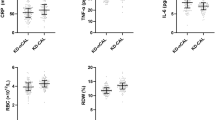Abstract
DNI is the immature granulocyte fraction provided by a blood cell analyzer, which is determined by subtracting the fraction of mature polymorphonuclear leukocytes from the sum of myeloperoxidase-reactive cells. We aimed to evaluate the role of Delta-neutrophil index (DNI) in cardiac prognosis prediction in children with Kawasaki disease (KD). Medical records of 193 patients were retrospectively reviewed. The values of DNI, white blood cells, erythrocyte sedimentation rate, the percent of polymorphonuclear leucocytes, C-reactive protein, aspartate transaminase, alanine aminotransferase, total bilirubin data of children with KD were analyzed. Also, sex and age of children were compared. The value of DNI was higher in children with cardiac complications [median 0.8 (0–0.26) vs 5.3 (3.55–8.95); P < 0.001]. The ROC curves showed that DNI was a better predictor of cardiac complications than other parameters. The best cutoff value for DNI to predict cardiac complications was 5.55% with sensitivity of 80% and specificity of 82% (AUC 0.883, 95% confidence interval [CI] 0.807–0.959, P < 0.05). DNI could serve as a facile and useful marker to predict cardiac complications in children with KD, as it is included in a routine complete blood count.



Similar content being viewed by others
References
Onouchi Yoshihiro (2018) The genetics of Kawasaki disease. Int J Rheum Dis 21(1):26–30
Ji Whan Han (2017) The efficacy and safety of high-dose intravenous immunoglobulin in the treatment of kawasaki disease: how can we predict resistance to intravenous immunoglobulin treatment of kawasaki disease? Korean Circ J 47(2):179–181
Burns JC, Franco A (2015) The immunomodulatory effects of intravenous immunoglobulin therapy in Kawasaki disease. Expert Rev Clin Immunol 11(7):819–825
Kim Soo-Jin (2018) Risk factors related to coronary artery outcome in Kawasaki disease. Korean Circ J 48(4):329–331
Egami K, Muta H, Ishii M et al (2006) Prediction of resistance to intravenous immunoglobulin treatment in patients with Kawasaki disease. J Pediatr 149(2):237–240
Kobayashi T, Inoue Y, Morikawa A (2008) Risk stratification and prediction of resistance to intravenous immunoglobulin in Kawasaki disease. Nihon Rinsho. Jpn J Clin Med 66(2):332–337
Newburger JW, Takahashi M, Gerber MA et al (2004) Diagnosis, treatment, and long-term management of Kawasaki disease a statement for health professionals from the Committee on Rheumatic Fever, Endocarditis, and Kawasaki Disease, Council on Cardiovascular Disease in the Young, American Heart Association. Pediatrics 114(6):1708–1733
Ministry of Health and Welfare, Research Committee on Kawasaki Disease (1984) Report of the subcommittee on standardization of diagnostic criteria and reporting of coronary artery lesions in Kawasaki disease. Ministry of Health and Welfare, Tokyo
Kratz A, Maloum K, O’Malley C et al (2006) Enumeration of nucleated red blood cells with the ADVIA 2120 hematology system: an international multicenter clinical trial. Lab Hematol 12(2):63–70
Lee Hye Young, Song Min Seob (2016) Serum NT-pro BNP levels and PMN percentage were significantly elevated in patients with KD with IVIG resistance and CAL. Korean J Pediatr 59(12):477–482
Jun H, Ko KO, Lim JW et al (2016) Age-adjusted plasma N-terminal pro-brain natriuretic peptide level in Kawasaki disease. Korean J Pediatr 59(7):298–302
Ha K-S, Lee J, Jang GJ et al (2015) Value of neutrophil-lymphocyte ratio in predicting outcomes in Kawasaki disease. Am J Cardiol 116(2):301–306
Kobayashi T, Inoue Y, Takeuchi K et al (2006) Prediction of intravenous immunoglobulin unresponsiveness in patients with Kawasaki disease. Circulation 113:2606–2612
Muta H, Ishii M, Furui J et al (2006) Risk factors associated with the need for additional intravenous gamma-globulin therapy for Kawasaki disease. Acta Paediatr 95(2):189–193
Song D, Yeo Y, Ha K et al (2009) Risk factors for Kawasaki disease-associated coronary abnormalities differ depending on age. Eur J Pediatr 168(11):1315–1321
Nakamura Y, Yashiro M, Uehara R et al (2004) Use of laboratory data to identify risk factors of giant coronary aneurysms due to Kawasaki disease. Pediatr Int 46(1):33–38
Cornbleet PJ (2002) Clinical utility of the band count. Clin Lab Med 22(1):101–136
Kim HW, Ku S, Jeong SJ et al (2012) Delta neutrophil index: could it predict mortality in patients with bacteremia? Scand J Infect Dis 44(7):475–480
Seok Y, Choi JR, Kim J et al (2012) Delta neutrophil index: a promising diagnostic and prognostic marker for sepsis. Shock 37(3):242–246
Nahm CH, Choi JW, Lee JW (2008) Delta neutrophil index in automated immature granulocyte counts for assessing disease severity of patients with sepsis. Ann Clin Lab Sci 38(3):241–246
Lee SM, Eun HS, Namgung R et al (2013) Usefulness of the delta neutrophil index for assessing neonatal sepsis. Acta Paediatr 102(1):e13–e16
Kong T, Kim TH, Park YS et al (2017) Usefulness of the delta neutrophil index to predict 30-day mortality in patients with ST segment elevation myocardial infarction. Sci Rep 7(1):15718
Author information
Authors and Affiliations
Contributions
Substantial contributions to the conception or design of the work; or the acquisition, analysis, or interpretation of data for the work; all authors. Drafting the work or revising it critically for important intellectual content; all authors. Final approval of the version to be published; all authors. Agreement to be accountable for all aspects of the work in ensuring that questions related to the accuracy or integrity of any part of the work are appropriately investigated and resolved; all authors. All authors take full responsibility for the integrity of the study and the final manuscript. No part of the manuscript has been copied from elsewhere or previously published in whole or in part.
Corresponding author
Ethics declarations
Conflict of interest
All authors declare they have no conflict of interest.
Ethical approval
The Institutional Review Board (IRB) of Konyang University Hospital approved. Approval number: 2019-01-009. Date of approval; 2019. 01.16.
Informed consent
Informed consent was exempted by the IRB.
Additional information
Publisher's Note
Springer Nature remains neutral with regard to jurisdictional claims in published maps and institutional affiliations.
Rights and permissions
About this article
Cite this article
Lee, S.H., Ko, K.O., Lim, J.W. et al. Delta-neutrophil index: a potential predictor of coronary artery involvement in Kawasaki disease by retrospective analysis. Rheumatol Int 39, 1955–1960 (2019). https://doi.org/10.1007/s00296-019-04448-9
Received:
Accepted:
Published:
Issue Date:
DOI: https://doi.org/10.1007/s00296-019-04448-9



